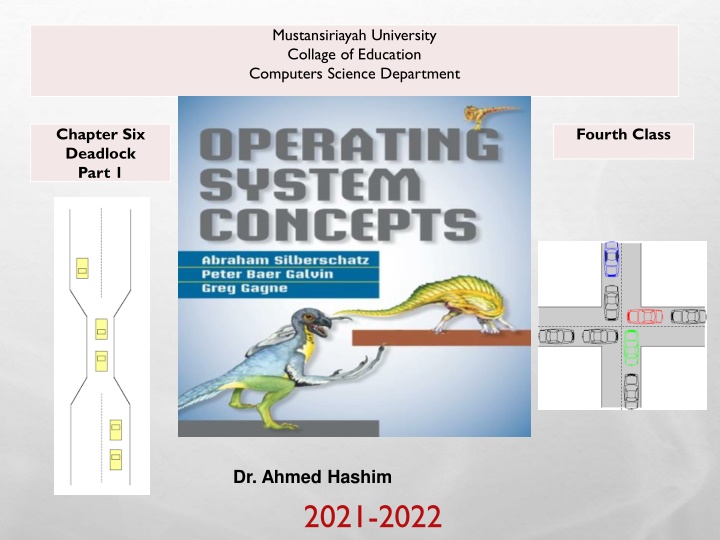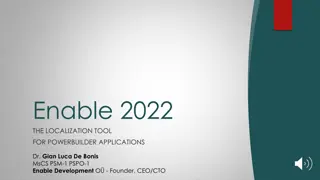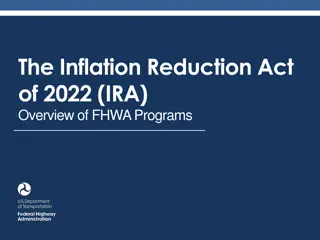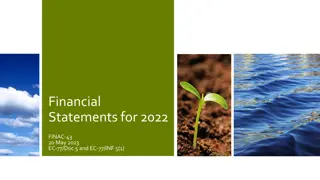
Understanding Deadlock in Multiprogramming Environments and System Models
Learn about deadlock in a multiprogramming environment where processes compete for resources, leading to a waiting state that can result in deadlocks. Explore system models, resource types, and scenarios illustrating deadlock situations involving the same or different resource types.
Download Presentation

Please find below an Image/Link to download the presentation.
The content on the website is provided AS IS for your information and personal use only. It may not be sold, licensed, or shared on other websites without obtaining consent from the author. If you encounter any issues during the download, it is possible that the publisher has removed the file from their server.
You are allowed to download the files provided on this website for personal or commercial use, subject to the condition that they are used lawfully. All files are the property of their respective owners.
The content on the website is provided AS IS for your information and personal use only. It may not be sold, licensed, or shared on other websites without obtaining consent from the author.
E N D
Presentation Transcript
Mustansiriayah University Collage of Education Computers Science Department Chapter Six Deadlock Part 1 Fourth Class Dr. Ahmed Hashim 2021-2022
6.1.Deadlock In a multiprogramming environment, several processes may compete for a finite number of resources. A process requests resources; if the resources are not available at that time, the process enters a waiting state. processes . . processes process Sometimes, a waiting process is never again able to change state, because the resources it has requested are held by other waiting processes. This situation is called a deadlock. process Deadlock waiting processes . operating systems typically do not provide deadlock-prevention facilities, and it remains the responsibility of programmers to ensure that they design deadlock- free programs. Deadlock . Deadlock
6.1.1. System Model System consists of a finite number of resources Resource types R1, R2, . . ., Rm CPU cycles, memory space, I/O devices Each resource type Ri has Wi instances. A process must request a resource before using it and must release the resource after using it. process A process may request as many resources as it requires to carry out its designated task. The number of resources requested may not exceed the total number of resources available in the system. . process .
System Model Cont. Under the normal mode of operation, a process may utilize a resource in only the following sequence: 1. Request: The process requests the resource. If the request cannot be granted immediately (for example, if the resource is being used by another process), then the requesting process must wait until it can acquire the resource. process ) . ( process . process 2. Use: The process can operate on the resource (for example, if the resource is a printer, the process can print on the printer). process printer process , : ( . Printer . 3.Release: The process releases the resource. process
To illustrate a deadlocked state: consider a system with three CD R/W drives. Suppose each of three processes holds one of these CD R/W drives. If each process is now requesting another drive, the three processes will be in a deadlocked state. Each is waiting for the event CD RW is released, which can be caused only by one of the other waiting processes. This example illustrates a deadlock involving the same resource type. Deadlock . process : CD R / W. - processes CD - R / W processes waiting processes . . process " Deadlock . " - CD RW . - Deadlock
Deadlocks may also involve different resource types. For example, consider a system with one printer, and one DVD drive. Suppose that process Pi is holding the DVD and process Pj is holding the printer. If Pi requests the printer and Pj requests the DVD drive, a deadlock occurs. Deadlock . Pj . DVD DVD . process process Pi Pj Deadlock DVD Pi .
6.2. Deadlock Characterization In a deadlock, processes never finish executing, and system resources are tied up ( ), preventing other jobs from starting 6.2.1. Necessary Conditions Deadlock can arise if four conditions hold simultaneously( ). 1. Mutual exclusion: At least one resource must be held in a non-sharable mode; that is, only one process at a time can use the resource. If another process requests that resource, the requesting process must be delayed until the resource has been released. process : process . . process 2. Hold and wait: a process holding at least one resource and waiting to acquire additional resources held by other processes process processes :
Deadlock Characterization Cont. 3. No preemption: Resources cannot be preempted; that is, a resource can be released only by the process holding it, after that process has completed its task. process ) process ( : . 4. Circular wait:There exists a set {P0, P1, ..., Pn} of waiting processes, such that P0 is waiting for a resource held by P1, P1 is waiting for a resource held by P2, ., Pn-1 is waiting for a resource held by Pn, and Pn is waiting for a resource held by P0. waiting processes {P0, P1, ..., Pn} , P2 , Pn-1 , . Pn Pn P1 , P1 P0 P0
6.2.2. Resource-Allocation Graph Deadlocks can be described more precisely in terms of a directed graph called a system resource-allocation graph consists of: This graph consists of a set of vertices V and a set of edges E. The set of vertices V is partitioned into two different types of nodes: P = {P1, P2, , Pn}, the set consisting of all the processes in the system R = {R1, R2, , Rm}, the set consisting of all resource types in the system Request edge: A directed edge from process Pi to resource type Rj is denoted by Pi Rj; it signifies that process Pi, has requested an instance of resource type Rj, and is currently waiting for that resource. Assignment edge: edge from resource type Rj to process Pi is denoted by Rj Pi; it signifies that an instance of resource type Rj has been allocated to process Pi
We represent each process Pi, as a circle We represent each resource type Rj as a rectangle. Since resource type Rj may have more than one instance, we represent each such instance as a dot within the rectangle. Note that a request edge points to only the rectangle Rj, An assignment edge must also designate one of the dots in the rectangle (instance). When process Pi, requests an instance of resource type Rj, a request edge is inserted in the resource-allocation graph. When this request can be fulfilled, the request edge is instantaneously transformed to an assignment edge. When the process no longer needs access to the resource, it releases the resource; as a result, the assignment edge is deleted.
RESOURCE ALLOCATION GRAPH EXAMPLE The resource-allocation graph shown in the figure 6.1 depicts the following situation The sets P, R, and E: - P = {P1, P2, P3} - R = {R1, R2 ,R3, R4} - E = {P1 R1, P2 R3, R1 P2, R2 P2, R2 P1, R3 P3 } Resource instances: - One instance of resource type R1 - Two instances of resource type R2 - One instance of resource type R3 Figure 6.1 - Three instances of resource type R4 Process states: - Process P1 is holding an instance of resource type R2 and is waiting for an instance of resource type R1. - Process P2 is holding an instance of R1 and an instance of R2 and is waiting for an instance of R3. - Process P3 is holding an instance of R3.
Given the definition of a resource-allocation graph, it can be shown that, if the graph contains no cycles, then no process in the system is deadlocked. If the graph does contain a cycle, then a deadlock may exist. If each resource type has exactly one instance, then a cycle implies that a deadlock has occurred. Each process involved in the cycle is deadlocked. If each resource type has several instances, then a cycle does not necessarily imply that a deadlock has occurred. cycles cycles cycle several instances : Deadlock Deadlock process Deadlock one instance cycle . - . Deadlocked . - process . Deadlock cycle -
EXAMPLE 1: To illustrate this concept, we return to the resource-allocation graph depicted in Figure 6.1. Suppose that process P3 requests an instance of resource type R2. Since no resource instance is currently available, a request edge P3 R2 is added to the graph (Figure 6.2) R2 . PROCESSES ) , 6.2 process P3 ( request edge P3 R2 Figure 6.1 At this point, two minimal cycles exist in the system: 1- P1 R1 P2 R3 P3 R2 P1 2. P2 R3 P3 R2 P2 Processes P1, P2, and P3 are Deadlocked. Process P2 is waiting for the resource R3, which is held by process P3. Process P3 is waiting for either process P1 or process P2 to release resource R2. In addition, process P1 is waiting for process P2 to release resource R1.
EXAMPLE 2 Now consider the resource-allocation graph in Figure 6.3. In this example, we also have a cycle: P1 R1 P3 R2 P1 However, there is no deadlock. Observe that process P4 may release its instance of resource type R2. That resource can then be allocated to P3, breaking the cycle. process P4 Deadlock cycle . . , P3 R2 BASIC FACTS If graph contains no cycles no deadlock. If graph contains a cycle - if only one instance per resource type, then deadlock. - if several instances per resource type, possibility of deadlock






















